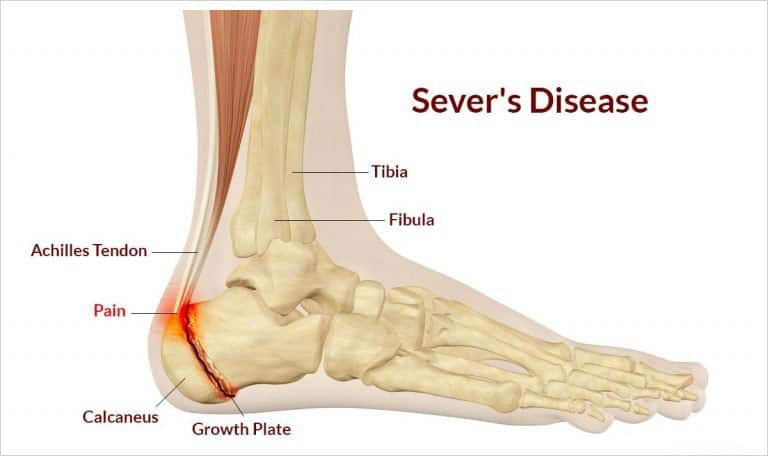A 10-Year-Old Boy With Heel Pain After Walking To School
History – Heel Pain After Walking
A mother of two children presented to the Sydney heel pain clinic with her 10-year-old boy who was complaining of heel pain after walking to school. He was experiencing heel pain in both feet and had been struggling for approximately 4 months. His mum explains to the sports podiatrist that he would complain of pain in both heels after physical activity and walking in general. His mum was extremely concerned as he also described heel pain after walking around the floorboards at home. This young boy was otherwise fit and healthy and was physically active. He plays basketball and football at school and engaged in approximately 5 sessions of sporting activity each week. The heel pain that he experienced was also quite severe after his sporting activity. His mum describes a significant growth spurt and an increase of two shoe sizes in 6 months. The 10-year-old schoolboy paid a visit to his local doctor who referred the family to the local imaging center for x-ray. The findings from the x-rays were of no particular significance and did not lead to any specific treatment plan. Please note that the most common cause of heel pain in children between 7 to 14 years of age is Severs syndrome which is a growth plate problem in the heel. X-ray imaging does not necessarily confirm the diagnosis of Severs. Moreover, the signs and symptoms such as heel pain after walking and tenderness with palpation of the posterior and plantar heel surface are more useful in determining the diagnosis. Severs is also more common in physically active children and in particular those who are growing quickly.
In frustration, the mother of this child paid a visit to her local physiotherapist who recommended stretching and strengthening exercises. After 5 weeks of physiotherapy there was no significant improvement. The mother was concerned that she was to blame and that her footwear choice had led to the problem. She was reassured that this was not the case and that the school shoes were typical school shoes worn by most children. The 10-year-old school boy explained to the sports podiatrist that he did feel some relief if he applied cold ice packs to his heels in the afternoon after walking home from school. The heel pain after walking home from school was more severe than the pain experienced in the mornings. The mother explained that the child had been forced to reduce his physical activity and was disappointed that he was unable to participate in as much sport as he would like to. In addition to heel pain after walking, it was apparent that there was significant heel pain after running and sprinting, which is typical for inflammatory heel conditions.
Why had the Child Developed Heal Pain After Walking, and Running?
In order to determine the cause of this patient’s heel pain after walking to school the sports podiatrist carried out a biomechanical assessment on the treadmill and a thorough physical assessment was performed. Foot measurements were taken in the standing, weight bearing position and the semi weight bearing position. Arch heights were measured and rear foot angle and calcaneal bisection were also measured. The podiatrist assessed the patient for ligament laxity and also analysed the range of motion through the foot and ankle. Firm pressure was applied to the posterior aspect of the calcaneus and the base of the heel and the patient reported significant pain, similar to the heel pain after walking to and from school. The sports podiatrist confirmed the diagnosis of Severs syndrome.

It was a parent after the physical and biomechanical assessment that this young boy demonstrated a genetic soft ligament type within the foot and ankle, and this was leading to extreme foot instability. During gait there was significant over pronation bilaterally with severe heel eversion in both feet. Both inner longitudinal foot arches were low and measured between 10 and 12 mm bilaterally. It was explained to the mother that due to the child’s age he demonstrated a weaker foot type which may strengthen post adolescence. Once again the patient was reassured that these findings were quite common and quite normal. it was also explained to the patient and the patient’s mother that Severs syndrome is a condition that children grow out of once the heel bone develops and naturally fuses. The heel pain after walking to and from school would subside with treatment. Treatment options were discussed in order to make the child more comfortable and assist in his physical movement during the developmental stages of foot growth.
Treatment Plan to Reduce the Heel Pain After Walking to and from School
In order to reduce the heel pain after walking to and from school the sports podiatrist outlined a multifactorial treatment plan.
Primarily it was important to reduce the load through the Achilles tendon due to the excess pulling on the posterior aspect of the heel bone. The pulling of the calf muscle through the Achilles tendon onto the heel would certainly be a contributing factor in the heel pain after walking, jogging and running. Therefore, the patient was advised to use 12 mm heel lifts inside his footwear at all times. Calf stretching was demonstrated and instructed. The patient’s mother installed the Sydney heel pain mobile phone application which contained the information outlining the detailed treatment plan. The stretching technique with diagrams was included in the application. A list of useful treatments and importantly a list of things to avoid were also included in the mobile phone application. The 12 mm heel lifts would certainly reduce the heel pain after walking but it was also important that the patient begin to perform regular calf stretching. Due to the foot instability and excessive for pronation, rigid sports type was applied to both feet in order to provide extra support. This would reduce the strain on the foot and ankle and therefore unload the stress on the heel. With the rigid sports tape in place the patient began to walk around the corridors and the treatment rooms and provided feedback. Immediately, there was a rapid reduction in heel pain after walking around the clinic.
This implied that the inherent foot weakness was a contributing factor and that stabilising both feet and ankles would assist in reducing the heel pain from the Severs syndrome. The footwear that the patient was using had become significantly worn and had compressed quickly. Arrangements were made for the school boy to wear non standard shoes in the form of orthopedic style footwear offering extra support. These shoes were readily available in athletes foot. These shoes would assist and relieve the heel pain after walking but would not be appropriate for use during sporting activity. Therefore, the sports podiatrist requested that’s the patient return within the next week so that his sporting footwear could also be assessed. At this appointment they would have the opportunity to discuss progress and also reapply the rigid sports tape. At the 1 week follow up appointment the patients mother was satisfied and reported that her son had much less heel pain after walking to and from school. The school boy reported to the sports podiatrist that he felt stable and supported with the rigid sports tape in place. Sporting footwear assessment was made and further recommendations were provided. The patient was advised that he could return to physical activity providing that he was comfortable and able to do so. His pain levels would be the key factor in restricting the level and amount of physical activity. Patients mother reported that the child had been diligent and was performing calf stretches on a day-to-day basis.
The Sports podiatrist informed the patient and his mother that there would be no changes to the treatment plan due to the significant improvement and the lack of heal pain after walking. A follow-up appointment was made for 6 weeks and the patient was instructed to return to the clinic if there was a problem.
Please be advised that information contained in this case study is specific to one particular patient with heel pain after walking and should not be taken as medical advice. If you are suffering with foot or heel pain you should inquire with a medical practitioner.
This article was written by Rami Ghorra of Sydney Heel Pain Clinic.
Written by Karl Lockett


